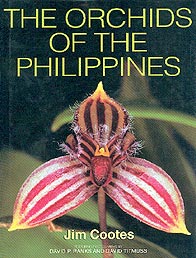THE ORCHIDS OF THE PHILIPPINES
by Jim Cootes
met foto’s van David P. Banks
en David Titmuss
2001 - Times Editions Singapore
232 pp. ontelbare foto’s
ISBN 981 232 100 4

Jim Cootes uit Australië begon in 1975 met het kweken van orchideeën.
Twee jaar later ging hij voor het eerst naar de Filippijnen en sinds
dan was hij daar minstens een keer per jaar. Van 1997 tot 2000 leefde
hij geruime tijd op de Filippijnen. Tijdens al die reizen bestudeerde
hij er intens de orchideeënflora en de orchideeën in hun natuurlijk
biotoop. Er werden twee orchideeënsoorten naar hem beschreven: Bulbophyllum cootesii en Dendrochilum cootesii.
Samen met David P. Banks beschreef hij een nieuwe orchideeënsoort: Amesiella monticola. In 1990 besloot Jim Cootes een
boek te schrijven over de Filippijnse orchideeën.
Dit boek is het meest recente werk over de orchideeën van de Filippijnen.
De auteur liet zich met raad en daad bijstaan door heel wat vermaarde
orchideeënspecialisten.
De auteur bespreekt in het kort de Filippijnse archipel en de belangrijkste
eilanden van die eilandengroep. Hij schenkt aandacht aan de ‘florale
zones’ (het laagland regenwoud, het laaggelegen bergregenwoud,
het Pinus-woud, het laaggelegen bergnevelwoud) en aan het klimaat. Dan
volgt er een 169 bladzijden lange bespreking van orchideeënsoorten
binnen alle mogelijke geslachten van A - Acanthephippium -
tot Z - Zeuxine. In het totaal bespreekt Jim Cootes meer dan
300 verschillende orchideeënsoorten en van elke soort is er een
foto ter illustratie. Van elke besproken soort vernemen we wie de plant
beschreven heeft, hoe ze aan haar naam kwam, waar ze groeit en in welke
habitat ze voorkomt en wat haar verspreiding is, hoe de plant en de
bloemen eruit zien en hoe groot ze zijn. Alhoewel niet alle foto’s
van uitstekende kwaliteit zijn, geven ze toch een duidelijk beeld van
de bloemen.
Jim Cootes schenkt in het kort ook aandacht aan het kweken van de Filippijnse
orchideeën. Hierbij heeft hij het over het ‘voor en tegen’
van het kweken op schors of in pot. Hij behandelt ook uiterst kort de
volgende onderwerpen: licht of schaduw, vochtigheid en luchtcirculatie,
water, voeding en temperatuur.
Tot slot publiceert hij een verklarende woordenlijst van een aantal
botanische termen en een uitgebreide bibliografie zodat al wie zich
dieper in de materie van de Filippijnse orchideeën wil inwerken
dit aan de hand van die interessante bibliografie kan doen. In een ‘appendix’
gaat hij nog wat dieper in op de Bulbophyllinae en Dendrobiinae.
Dit interessant boek wordt afgesloten met een checklist van de Filippijnse
orchideeën waarbij de in dit boek afgebeelde bloemen van een asterix
voorzien zijn.
Samen met de werken van
Valmayor H.L., ORCHIDIANA
PHILIPPINIANA uit 1984 en het door Valmayor samengestelde werk THE
COMPLETE WRITINGS OF DR. EDUARDO QUISUMBING ON PHILIPPINE ORCHIDS uit 1981 vormt dit werk een trilogie die voor de liefhebber van Filippijnse
orchideeën onmisbaar is.
(top)
Jim Cootes from Australia started growing orchids in 1975. Two years
later he went to the Philippines for the first time and since then he
was there at least once a year. He lived there for longer periods of
time from 1997 up till 2000. He studied the orchid flora and orchids
in there natural biotope intensively. Two orchid species were named
after him: Bulbophyllum cootesii and Dendrochilum cootesii. Together
with David P. Banks he described a new orchid species: Amesiella monicola.
In 1990, Jim Cootes decided to write a book about orchids of the Philippines.
This book is the most recent work on orchids of the Philippines. He
was advised and assisted by several renowned orchid specialists.
The auteur gives a short description of the Philippine archipelago and
the most important islands of that archipelago. He pays attention to
the ‘floral zones’ (the lowland rainforest, the lower mountain
rainforest, the Pinus forest, the lower mountain mist forest) and to
the climate. A description of 169 pages of orchid species within all
possible families from A - Acanthephippium – to Z – Zeuxine
– follows. In total Jim Cootes describes over 300 different orchid
species and a photograph of every species is available. Of every described
species, we learn who described the plant, how she got her name, where
she grows and in which habitat she lives, her spread, how the plant
and the flowers look like and how tall they are. Even though not all
pictures are of equal quality, they offer a clear view of the flowers.
Jim Cootes also pays brief attention to the growing of Philippine orchids.
With this he talks about the ‘pros and cons’ of growing
on bark or in pot. He also tackles the following subjects very briefly:
Light or shade, moist and air circulation, nutrition and temperature.
To conclude, he offers a glossary of a number of botanical terms and
an extensive bibliography so that everyone who wants to work up the
subject of Philippine orchids, can use this interesting bibliography.
In an appendix he goes more deeply into the Bulpophyllinea and the Dendrobiinae.
This book is closed of with a checlist of the Philippino orchids, marking
the flowers depicted in this book with an asterisk.
This book makes up a trilogy, essential for the devotee of Philippine
orchids, together with the works of
Valmayor H.L., ORCHIDIANA
PHILIPPINIANA from 1984 and the by Valmayor composed THE
COMPLETE WRITINGS OF DR. EDUARDO QUISUMBING ON PHILIPPINE ORCHIDS from 1981.
(top)